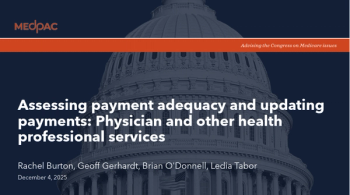
- April 10, 2019 edition
- Volume 96
- Issue 7
The physician-patient relationship has changed
Physicians must change with it.
Is the patient-physician relationship evolving or eroding?
The dynamic between patient and physician is in the midst of massive transformation, shifting as rapidly as the health systems surrounding it. This surpasses generational expectations, and is as much sociologic as it is ideologic and systematic.
New pathways to care, including telemedicine, urgent and retail clinics, impact how patients view their personal connection with any one given physician. Increasing sub-specialty care and advancing complexity of illness has led to a perceptible increase in the number of healthcare providers involved in a patient’s care across a lifetime.
Expansion of healthcare teams to include social workers, care coordinators and others alters the one-on-one dynamic and obscures the days of the solo family doctor or heroic surgeon. With the exception of areas of innovation such as direct primary care, it is yet to be discerned what number of different team members that a patient will accept before the sanctity of the individual relationship is lost.
Healthcare systems have done a poor job of communicating expectations and rationale for new pathways to care. The role of technology within the patient-physicians dynamic remains in flux, ill-defined, and inconsistent. Both patients and physicians are left with underlying confusion and uncertainty as they attempt to apply antiquated frameworks to navigate the modern healthcare environment.
Technology has revolutionized how patients interact with their own health as well as the structure of individual episodes of care. Clinicians access up-to-date resources at the click of a mouse. Computers and cell phones distract eyes and ears, often making listening a luxury for both parties. I am astounded by the number of patients who express guilt and sheepish admissions that they have researched their symptoms online.
I regularly encourage my patients to explore and understand their own health. I believe the past role of the physician as sole purveyor of knowledge is outmoded. Patients hold more information in the palms of their hands than I could ever hope to encapsulate in years of study.
My role as physician is now much more about intuitively and creatively interpreting and applying shared information and experience. Patients, literally armed with wearable devices and access to a limitless internet, can and should be empowered to fundamentally alter the nature and exchange within the relationship.
Physicians must be purposeful about how they initiate and maintain relationships. Expectation setting as well as clearly defined teams and roles are essential. Health systems and insurers must be more proactive in guiding appropriate pathways towards care and articulating the rationale for cost and decision-making, allowing physicians to focus more on the care they deliver.
Systemic frustration should not be triangulated in ways that directly harm the patient-physician relationship, as is now common.
Ultimately, I refuse to accept that the patient-physician relationship is on life support. Rather, it is possible to reframe the core structural elements of trust, access and continuity that allow the relationship to be successful and meaningful. For example, to many, the notion of continuity means seeing a given physician at every visit and that they be omnipresent in care delivery. A modern notion of continuity speaks to a cohesive team that delivers comprehensive care under the leadership of a physician. Access must be reconsidered within the contexts of telemedicine and the potentials of artificial intelligence to augment encounters with the healthcare team.
I still carry my uncle’s black leather handbag from the 1950s as I make my own modern house calls, though I now have the benefit of filling the bag with a point-of-care ultrasound, digital stethoscope and iPad. Perhaps this is an ideal image for how we should approach the modern patient-physician relationship, honoring the roots of the profession, while employing the benefit of new technologies and methods for team-based delivery of care.
It is the responsibility of both health delivery systems and physicians to share transparently a coherent vision of evolving practice and relationships, and to assure that this new vision achieves quality patient care. The physician-patient relationship must still provide the cohesion necessary for the patient to maintain trust, access and continuity that form the bedrock of the best patient- and physician-experience.
Aaron George, DO, is a family physician practicing in his hometown of Chambersburg, Penn. He was an Andlinger fellow in health policy with the Center for Public Health in Vienna, Austria, and has been awarded both the Bristol-Myers Squibb award for excellence in graduate medical education, as well as recently named one of the 40 under 40 physicians by the Pennsylvania Medical Society.
Articles in this issue
over 6 years ago
How to integrate health apps at the point of careover 6 years ago
The rising price of insulinover 6 years ago
Six tips to getting paid for CPT modifiersover 6 years ago
IT services at your practice: In-house or outsourced?over 6 years ago
Your voice: Primary care is dying because burdens are too greatover 6 years ago
New 2019 regulations for BMI codingover 6 years ago
The risk of direct careover 6 years ago
Getting off the corporate treadmillalmost 7 years ago
Top 4 healthcare trends for 2019Newsletter
Stay informed and empowered with Medical Economics enewsletter, delivering expert insights, financial strategies, practice management tips and technology trends — tailored for today’s physicians.















